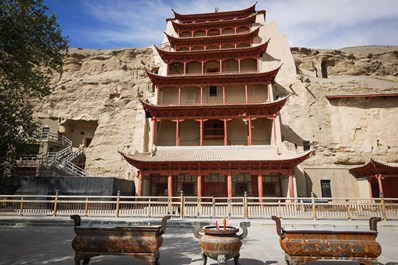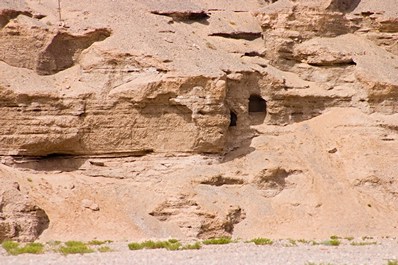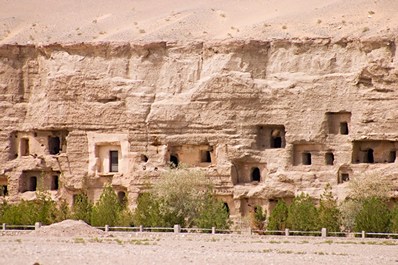The Mogao Caves, Dunhuang
The Mogao Caves - the search for enlightenment of Buddhist monks
Timeless Caves, Caves of a Thousand Buddhas - all these are the famous Mogao temple complex, located 25 kilometers from Dunhuang. Since 1987, the Mogao cave complex is included to the UNESCO World Heritage Site as one of the most unique monuments of the Buddhist religion, culture and art.
Besides the caves, which are small Buddhist temples, the complex consists of 5 wooden buildings, built from VII to XIII centuries. Now it contains over 50,000 Buddhist manuscripts. The inner part of the cave is decorated with wall paintings with a total length of more than 46,000 km2. In addition, almost every cave has statues of Buddha: from the smallest ones to the statues of several meters in height. The total territory of 700 caves includes 6,000 statues.
The history of Mogao begins in 366 BC. A Buddhist monk by name Le-Tsung saw a shine of Thousand Buddhas on the mountain top during his journey along the Great Silk Road. Taking this vision as a sign, he went to the mountain and cut through a first cave, where he spent a long time in meditation and prayer. This is an amazing story of Mogao grottoes, which were built by the followers of Buddhism from IV to XIV centuries. Over the period of thousands years, Buddhist pilgrims came there to get enlightenment.
Some of them cut down a small cave for themselves, while the others created the whole temples in miniature. Each of these caves was decorated with wall paintings, enabling us today to trace the history of Buddhism in China. The whole complex features numerous statues of Buddha with the largest one, a 30-m-high sitting Buddha, installed in 695 by order of a Chinese empress.
By XIV century the Silk Road lost its importance as a connecting trunk road between the East and the West. In addition, since the VIII century, Xinjiang was undergoing through an active process of Islamization, and Buddhism lost its dominant importance. The Mogao caves were forgotten and buried by sand almost for 5 centuries. And only a small group of monks, from generation to generation, kept maintaining this unique monument of Buddhist culture.
A new life of the cave complex began at the junction of the XIX and XX centuries, when in 1900 a monk Wang Yuanlu found a sealed cave with Buddhist texts. Since then, thousands of researchers, archaeologists and treasure hunters started a new pilgrimage to the Mogao caves.
Today the Mogao library is represented by thousands of documents in the Sanskrit, Sogdian, Chinese, Tibetan languages. The studies revealed not only unique Buddhist scrolls, but also Manichean, Christian and even Zoroastrian texts. So the Mogao library kept the most ancient text with a Zoroastrian prayer and the world-famous “Jesus Sutras”, which many researchers consider as an evidence of Jesus Christ’s journey to the East.
All the caves are connected by paths and wooden decks. Some of them strike with their sizes from the smallest caves, where you can just lie or sit hunched over, to huge ones to pray all together. There are caves with murals that make the visitor freeze in contemplation.
Many of the caves are very old and partially destroyed by time or “black archeologists”, who, in the early XX century, were exporting Mogao murals and sculptures by full boxes to European countries. However, neither people nor time could destroy the striking beauty of the Mogao caves, and today not only tourists, but also followers of all religions, like a thousand years ago, come to this famous temple in search of enlightenment.




